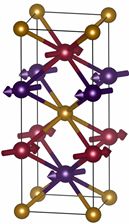

Crystal structure of Mn2Au with antiferromagnetically ordered magnetic moments
Ill./©: Libor Šmejkal, JGU
Within the emerging field of spin-based electronics, or spintronics, information is typically defined by the orientation of the magnetization of ferromagnets. Researchers have recently been also interested in the utilization of antiferromagnets, which are materials without macroscopic magnetization but with a staggered orientation of their microscopic magnetic moments.
Here the information is encoded in the direction of the modulation of the magnetic moments, the so-called Néel vector. In principle, antiferromagnets enable much faster information-writing and are very stable with respect to disturbing external fields.
These advantages, however, also imply a challenging manipulation and read-out processes of the Néel vector orientation. Up to now, this had been possible using the semimetal copper manganese arsenide CuMnAs only, a compound featuring several disadvantages concerning applications.
As published in the online science journal Nature Communications, scientists at the Institute of Phyics at Johannes Gutenberg University Mainz (JGU) were now able to demonstrate current-induced switching of the Néel vector also for metallic thin films of a compound consisting of manganese and gold, Mn2Au, which orders antiferromagnetically at high temperatures.
In particular, they measured a ten times larger magnetoresistance as observed for CuMnAs. The surprising magnitude of this effect is explained by extrinsic scattering on excess gold atoms, as deduced from calculations done by Libor Šmejkal, who in the framework of a collaboration with the Czech Academy of Sciences is currently conducting his PhD project in the group of Professor Jairo Sinova at Mainz University.
“These calculations are very important for the understanding of our experimental work mainly performed by Stanislav Bodnar, who is a PhD student in our group. We identified Mn2Au as a prime candidate for enabling future antiferromagnetic spintronics,” explained PD Dr. Martin Jourdan, project leader of the study. “Aside from the large magnetoresistance of this compound, other important advantages are its non-toxic composition and the fact that it can be used even at higher temperatures.”
Spintronics is a major field of research at the Institute of Physics at Johannes Gutenberg University Mainz, mainly pursued in the groups of Professor Jairo Sinova (theory) and Professor Mathias Kläui (experiment). The study was financially supported by the Transregional Collaborative Center Spin+X of TU Kaiserslautern and Johannes Gutenberg University Mainz.
Image:
http://www.uni-mainz.de/bilder_presse/08_physik_antiferromagnet_mn2au.jpg
Crystal structure of Mn2Au with antiferromagnetically ordered magnetic moments
Ill./©: Libor Šmejkal, JGU
Publication:
Stanislav Yu. Bodnar et al.
Writing and reading antiferromagnetic Mn2Au by Néel spin-orbit torques and large anisotropic magnetoresistance
Nature Communications, 24 January 2018
DOI: 10.1038/s41467-017-02780-x
http://www.nature.com/articles/s41467-017-02780-x
Contact:
PD Dr. Martin Jourdan
Institute of Physics
Johannes Gutenberg University Mainz
55099 Mainz, GERMANY
phone +49 6131 39-23635
fax +49 6131 39-24076
e-mail: jourdan@uni-mainz.de
https://www.klaeui-lab.physik.uni-mainz.de/martin-jourdan/
Related links:
https://www.klaeui-lab.physik.uni-mainz.de/ – Kläui Lab
https://www.sinova-group.physik.uni-mainz.de/ – Interdisciplinary Spintronics Research Group
http://www.uni-kl.de/trr173/home/ – Transregional Collaborative Research Center 173: Spin+X – Spin in its collective environment
Read more:
http://www.uni-mainz.de/presse/aktuell/2533_ENG_HTML.php – press release “Nanostructures can be deliberately manipulated”, 5 September 2017












